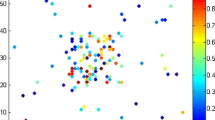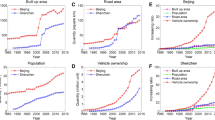Abstract
An integrated co-evolution model with the consideration of land use and traffic network design is proposed in this paper. In the suggested model, two kinds of economic agents are considered. On the one hand, the government makes the investment decision for the traffic network improvement based on the current traffic condition under the limited budget. On the other hand, households and companies will choose their locations according to the attraction of each traffic zone related to the road network accessibility and the housing price. Therefore, the land use is indicated by the population and employment distributions through the evolution process. Besides, the improvement of road capacity is modeled by a general bi-level programming of traffic network design. Simulation experiments show that the city will be more efficient and will have higher average accessibility for employment and population in the evolution process.











Similar content being viewed by others
References
Alonso W (1964) Location and land use: toward a general theory of land rent [M]. Harvard University Press, Cambridge
Anas A (1978) Dynamics of urban residential growth [J]. J Urban Econ 5(1):66–87
Barthélemy M, Flammini A (2009) Co-evolution of density and topology in a simple model of city formation [J]. Netw Spat Econ 9(3):401–425
Batty M (2007) Cities and complexity: understanding cities with cellular automata, agent-based models, and fractals [M]. The MIT press, Cambridge
Batty M, Xie Y, Sun Z (1999) Modeling urban dynamics through GIS-based cellular automata [J]. Comput Environ Urban Syst 23(3):205–233
Beckmann MJ (1969) On the distribution of urban rent and residential density [J]. J Econ Theory 1(1):60–67
Beckmann MJ (1974) Spatial equilibrium in the housing market [J]. J Urban Econ 1(1):99–107
Bravo M, Briceno L, Cominetti R et al (2010) An integrated behavioral model of the land-use and transport systems with network congestion and location externalities [J]. Transp Res B Methodol 44(4):584–596
Carlino G, Chatterjee S (2002) Employment deconcentration: a new perspective on America’s postwar urban evolution [J]. J Reg Sci 42(3):445–475
Chang JS, Mackett RL (2006) A bi-level model of the relationship between transport and residential location [J]. Transp Res B Methodol 40(2):123–146
Dendrinos DS, Mullally H (1981) Evolutionary patterns of urban populations [J]. Geogr Anal 13(4):328–344
Dendrinos DS, Mullally H (1985) Urban evolution: studies in the mathematical ecology of cities [M]. Oxford University Press, Oxford
El-Geneidy AM, Levinson DM (2006) Access to destinations: development of accessibility measures[R]
Frank M, Wolfe P (1956) An algorithm for quadratic programming [J]. Nav Res Logist Q 3(1–2):95–110
Gao Z, Zhang H, Sun H (2004) Bi-level programming models, approaches and applications in urban transportation network design problems [J]. Commun Transp Syst Eng Inf 4(1):35–44
Geurs KT, van Wee B (2004) Accessibility evaluation of land-use and transport strategies: review and research directions [J]. J Transp Geogr 12(2):127–140
Hansen WG (1959) How accessibility shapes land use [J]. J Am Inst Planners 25(2):73–76
Hurtubia R, Bierlaire M (2014) Estimation of bid functions for location choice and price modeling with a latent variable approach [J]. Netw Spat Econ 14(1):47–65
Karoonsoontawong A, Lin DY (2015) Combined gravity model trip distribution and paired combinatorial logit stochastic user equilibrium problem [J]. Networks and Spatial Economics: 1–38
Krugman P (1991) Geography and trade [M]. The MIT press, Cambridge
Levinson D, Yerra B (2006) Self-organization of surface transportation networks [J]. Transp Sci 40(2):179–188
Levinson D, Xie F, Zhu S (2007) The co-evolution of land use and road networks [J]. Transportation and traffic theory: 839–859
Li X, Yeh AGO (2000) Modelling sustainable urban development by the integration of constrained cellular automata and GIS [J]. Int J Geogr Inf Sci 14(2):131–152
Li L, Sato Y, Zhu H (2003) Simulating spatial urban expansion based on a physical process [J]. Landsc Urban Plan 64(1):67–76
Li ZC, Lam WHK, Wong SC et al (2012) Modeling the effects of integrated rail and property development on the design of rail line services in a linear monocentric city [J]. Transp Res B Methodol 46(6):710–728
Li ZC, Chen YJ, Wang YD et al (2013) Optimal density of radial major roads in a two-dimensional monocentric city with endogenous residential distribution and housing prices[J]. Reg Sci Urban Econ 43(6):927–937
Ma XS, Lo HK (2012) Modeling transport management and land use over time [J]. Transp Res B Methodol 46(6):687–709
Ma XS, Lo HK (2013) On joint railway and housing development strategy [J]. Transp Res B Methodol 57(SI):451–467
Martínez FJ (1992) The bid-choice land-use model: an integrated economic framework [J]. Environ Plan A 24(6):871–885
Martinez FJ, Henriquez R (2007) A random bidding and supply land use equilibrium model [J]. Transp Res B Methodol 41(6):632–651
McDonald JF (2009) Calibration of a monocentric city model with mixed land use and congestion [J]. Reg Sci Urban Econ 39(1):90–96
Santé I, García AM, Miranda D et al (2010) Cellular automata models for the simulation of real-world urban processes: a review and analysis [J]. Landsc Urban Plan 96(2):108–122
Sheffi Y (1985) Urban transportation networks: equilibrium analysis with mathematical programming methods [J]. Transp Res Part A: Gen 20(1):76–77
Sun H, Gao Z, Szeto WY, Long J, Zhao F (2014) A distributionally robust joint chance constrained optimization model for the dynamic network design problem under demand uncertainty [J]. Netw Spat Econ 14(3–4):409–433
Wagner DF (1997) Cellular automata and geographic information systems [J]. Environ Plan B 24:219–234
Wu J, Xu M, Gao Z (2013) Coevolution dynamics model of road surface and urban traffic structure [J]. Nonlinear Dynamics: 1–8
Xie XJ (2008) Calibration method and comparison of gravity model [J]. Commun Stand 8:17–20
Xie F, Levinson D (2009) Modeling the growth of transportation networks: a comprehensive review [J]. Netw Spat Econ 9(3):291–307
Xu T, Wei H, Hu G (2009) Study on continuous network design problem using simulated annealing and genetic algorithm [J]. Expert Syst Appl 36(2):1322–1328
Yamins D, Rasmussen S, Fogel D (2003) Growing urban roads [J]. Netw Spat Econ 3(1):69–85
Zhang L, Levinson D (2005) Road pricing with autonomous links [J]. Transp Res Rec: J Transp Res Board 1932(1):147–155
Zhang L, Peng GX (2009) Simple method and application on calibration of the gravity model [J]. Technol Econ Areas Commun 11(1):106–108
Zhang L, Xu W, Li M (2009) Co-evolution of transportation and land use: modeling historical dependencies in land use and transportation decision-making[R]
Acknowledgments
This paper is partly supported by the National Natural Science Foundation of China (71322102, 71271024), the National Basic Research Program of China (2012CB725401), Program for New Century Excellent Talents in University (NCET-12-0764), the Fundamental Research Funds for the Central Universities (2015YJS093).
Author information
Authors and Affiliations
Corresponding authors
Rights and permissions
About this article
Cite this article
Li, T., Wu, J., Sun, H. et al. Integrated Co-evolution Model of Land Use and Traffic Network Design. Netw Spat Econ 16, 579–603 (2016). https://doi.org/10.1007/s11067-015-9289-3
Published:
Issue Date:
DOI: https://doi.org/10.1007/s11067-015-9289-3




